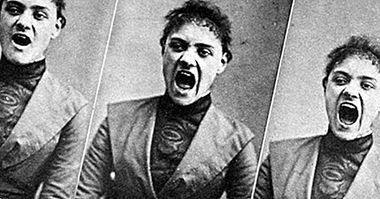Family therapy: types and forms of application
When we think of someone doing therapy, we usually imagine an individual session in which a person interacts with the psychologist. We may also conceive the possibility of a group session , with different people with the same type of problem.
But there is also a type of therapy that is applied to a family group, the so-called family therapy , in which conflicting aspects are treated between members of the same family. In this article we tell you what it is and what it is used for.
What is this type of psychological intervention?
Family therapy is understood as that type of therapy centered on the family as an object of intervention. The objective is to strengthen and provide resources to the family so that they can act in a collaborative manner thanks to it. settle disputes and conflicts they may have among themselves or problems of a single individual.
The family is understood as a basic element in the development of the human being, by representing the fundamental element that allows the infant to acquire a model regarding how to see, act, relate and communicate with the world. It is an essential element when learning emotional and relational aspects, with great influence on development.
That is why in this type of treatment you try to involve two or more members of the same family in order to observe and, if necessary, modify, the patterns of interaction between the members of the family.
It is conceived that the internal problem of an individual is preceded by the presence of interpersonal conflicts, which when internalized can cause symptoms. The pathological is linked to the non-acceptance of new roles in one of the individuals, with the roles and communication at the base of the existence of numerous mental and social problems.
Family therapy and the systemic perspective
One of the main currents and the one that is most linked to this type of therapy is the systemic current . From this perspective, the family is conceived as a system, a set of elements whose sum generates a result greater than the simple addition of each of them, arising from their interaction new elements, properties and characteristics.
For the systemic perspective, the behavior and state of one of the components of the family can not be understood separately from the system, influencing the system in each individual and vice versa. The family would be an open system, receiving information from the environment, being affected by the environment and exchanging information with it in order to adapt and survive. Each of the members is thus affected by the medium.
- Related article: "Systemic therapy: what is it and on what principles is it based?"
Change behavior dynamics
From the systemic model it is not intended to directly modify the problematic behavior , but to change the family dynamics and the pattern that provoke, facilitate or give utility or meaning. A more indirect path is sought in order to achieve the same goal, while at the same time improving and strengthening the positive family dynamics and the strengths of both the system and each of its components.
Some of the key aspects of systemic family therapy are communication processes (in which incongruent communication styles are used at the analogue or digital level, the affectivity and emotion expressed or the presence of rigidity), the assignment of roles and the need to change of these, the clear or diffuse structure of the family and the limits between the people that can allow or inhibit the process of creating an own and autonomous identity, the negotiation in conflicts or the establishment of power relations between the members of the family.
exist multitude of schools and techniques even within the same perspective . The school of Milan, the structuralist school of Minuchin or the school of Palo Alto are examples of different perspectives within the systemic current. In terms of specific techniques, the prescription of tasks, the imbalance (allying temporarily with one of the components of the system to change family limits), the dramatization, the redefinition of symptoms in a positive way, the paradoxical intention or the instigation.
The properties of the family system
Different properties are given within the system:
1. Circular causality
The behavior of a member of the system is influenced by that of others , as well as its own influences the rest of the system. If one shouts the rest will have a reaction, while the reaction will generate a response in the first.
2. Totality
The system generates its own responses due to the interaction, being more than the mere sum of its parts.
3. Equifinality
Different people can reach the same point through different paths. In this way two people they can get to wake up anxiety (for example) from different stimulations.
4. Equicausity
The opposite of equifinality. The same point of departure can lead to different conclusions. Thus, an event will be lived differently by different people.
5. Homeostasis
The system tends to try to find a state of equilibrium. This causes deep changes to be necessary in order to keep them in time, or else you could go back to the original state. On the other hand, if a consistent change is achieved that is integrated into the system, it can be maintained over time.
Family therapy from other perspectives
When we talk about family therapy, we are generally associating it with a type of treatment linked to the systemic current. However, and despite the fact that the development of family therapy is closely linked to this current of thought, throughout history there have been many theoretical perspectives that have worked with this type of therapy. In this sense we can find that, in addition to the systemic perspective, this form of therapy has been, among others, worked from the two that you can see below.
Psychodynamic perspective
Some currents of psychoanalysis have also applied aspects of family therapy, especially those that follow the theory of object relations. From this perspective, the symptom of a patient is seen as indicative of the failure to resolve the development sequence of one or both parents.
The existing conflicts they make the emotion of the infant look repressed , which on the one hand causes the father in conflict to remember and relive his lack of development resolution and on the other that this reflects his conflicts in the treatment of his son. Therapy focuses on visualizing and working with the transference and countertransference relationships in order to help the whole family to solve their development sequences.
- Related article: "The 9 types of Psychoanalysis (theories and main authors)"
Cognitive-behavioral perspective
From this perspective, the therapy focuses on the direct resolution of a specific problem presented by the family or one of its members, the objective being quite specific.
Couples therapy, training for parents or psychoeducation are some modalities that have been treated from this perspective. In some cases, the family can be employed as a co-therapist, if the objective is to modify the behavior of one of the members. But it can also serve to solve dysfunctional aspects of one's family.
- Perhaps you are interested: "Behavioral Cognitive Therapy: what is it and on what principles is it based?"
Applications of this type of therapy
Family therapy has been used since its inception to help solve various types of problems. Among them can be found the following.
1. Family crisis
The existence of intrafamilial problems that can not be solved by traditional means have frequently been a reason for consultation in family therapy. A difficult situation, aspects linked to the life cycle as the birth of children or the arrival of their emancipation, a death whose mourning has not been elaborated or some latent conflict between its members are valid examples.
2. Couple therapy
Couples therapy is one of the subtypes of family therapy there is. Overcoming problems in the couple such as lack of communication, exhaustion, infidelity or incompatibility in some aspects of life are some of the most frequent reasons for consultation.
3. Behavioral problems or mental disorders in one of the members
Especially when the subject in question is one of the children, it is not strange that the parents decide to try to remedy it. In many cases, parents or family members can be employed as co-therapists who can facilitate the maintenance of changes and the follow-up of programs established by the therapist.
Likewise, in other cases the problems presented can be strongly influenced by the communication patterns of families (for example, unstructured homes or couples who continually argue can contribute to emotional and behavioral problems).
4. Treatment of addictions and other disorders
In the treatment of various addictions and even other psychological disorders can be very useful to integrate the closest relatives, so that they can help the subject to stay away from stimuli that elicit the response of consumption . They can also participate in making the subject see the need to continue with the treatment and the advantages of stopping consuming, as well as reinforcing the behaviors that favor their recovery.
5. Psychoeducation
Psychoeducation with families can be fundamental in order to help understand a person's situation, what can be expected, what they can do to help them or the steps they need to take.
6. Parent training
Training for parents is a great advantage for those parents who have children with behavioral problems or who do not know how to face specific situations that are being experienced throughout their development. Teaching how to cope with maladaptive behaviors through the molding and a positive stimulation that allows the minor to adapt.
The position of the therapist
Within family therapy, the therapist has a particular role. Although it depends on the perspective from which family therapy is applied, as a general rule the professional must stay in an equidistant position among all family members present in therapy, without taking sides with any of its members. It must ensure that all members can give their opinion and that it is heard and valued by the other participants.
Depending on the case and the family therapy modality, occasionally it can establish temporary alliances with one of the members to focus the group's attention on certain aspects, but later it has to return to a neutral position and / or.
In some cases it will remain as an external and cold element that it limits itself to pointing out the family functioning patterns, while in other cases it may be necessary to represent the role of another family member in order to introduce a new element in the therapy and help to make the different points of view appear.
Bibliographic references:
- Almond, M.T. (2012). Psychotherapies CEDE Preparation Manual PIR, 06. CEDE: Madrid.
- Minuchin, S. (1974). Families and family therapy. Gedisa: Mexico.
- Ochoa, I. (1995). Approaches in systemic family therapy. Herder: Barcelona.



















